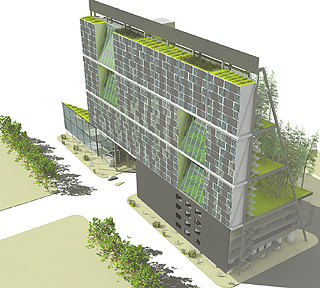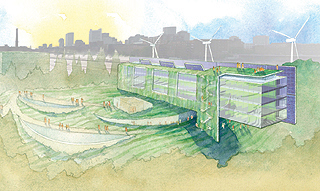|
Subscribe / Renew |
|
|
Contact Us |
|
| ► Subscribe to our Free Weekly Newsletter | |
| home | Welcome, sign in or click here to subscribe. | login |
Environment
| |
May 1, 2007
Mithun and Perkins + Will win green design contest
Journal Staff Reporter

In an effort to push the sustainable building envelope, the Living Future Conference last week included a design contest. Perkins + Will's State Office Building and Mithun's design for the Center for Urban Agriculture walked away with dual best in show prizes for their concepts.
Perkins + Will won the “most realizable” project award while Mithun won the “most visionary” award.
The competition challenged locals in the design and construction industries to create a structure that could produce all the energy and water it needs. It was open to architects, engineers, design professionals, students and green builders. Nineteen proposals were submitted.
All entries were designed to meet the standards of the Living Building Challenge, a new green design standard written by Jason McLennan of the Cascadia Region U.S. Green Building Council and published last December. The challenge has 16 requirements that range from producing all the energy a building needs to being located on a site that won't negatively affect wetlands, wildlife habitat or farmland.
The judges were McLennan, Tom Paladino of Paladino & Co. and Susan Jones of atelierjones. The entries were divided into two categories: realizable projects and visionary projects.
Jones said realizable projects, especially the work of Perkins + Will, were impressive because groups were working with living building ideas but were on a budget. The visionary projects are intended to “more radically change how we think about buildings.”

Perkins + Will's entry for the State Office Building is a modification of a building the firm pre-designed in Bellevue. The project's design goals were natural ventilation, daylighting, views from all workstations and energy conservation. The building has two sides: a highway side where the building acts as a billboard for sustainability and a forest side where the goal is to help restore the ecology of the site.
Here are some of its sustainable features:
• Double-skin facade. The facade acts as a freeway buffer, blocking heat, noise and pollution.
• Energy production
• Water treatment and reuse. The building treats and reuses water through a rooftop rainwater collector, blackwater tank, green roof, filtration tubes, bioswales and a constructed wetland.
• Natural ventilation. Operable windows bring in moist air from the forest while a void in the facade draws out hot air.
Jones said Mithun's project was outstanding in its beauty, which is one requirement of the living building challenge. “As one of the goals was to create something of beauty, for us it was very alluring.”
Mithun's project was for the Center for Urban Agriculture, and could be located at Ninth Avenue and Denny Way in Seattle.
Here are some of its sustainable features:
• Energy and water. The building would have about 35,000 square feet of photovoltaic cells. Rainwater is captured, filtered and stored through multiple levels of planters, terraces and gardens.
• Food and knowledge. The building would use “farm fields” that combine classroom and lab space to create a learning center. A chicken farm would be located on a lower terrace. Greenhouses and rooftop gardens would offer additional food production space.
• Plants and ideas. The building would create habitat, farmland and community gathering space on the site.
• People and community. The Greenhouse Restaurant and Sidewalk Cafe offer the public a chance to taste food grown in an urban environment. There would be 318 housing units.
Cash prizes for various award winners range between $500 and $3,500.
The Living Future Competition was sponsored by the Cascadia Region Green Building Council and Paladino & Co.
Katie Zemtseff can be
reached by email or by phone
at (206) 622-8272.


